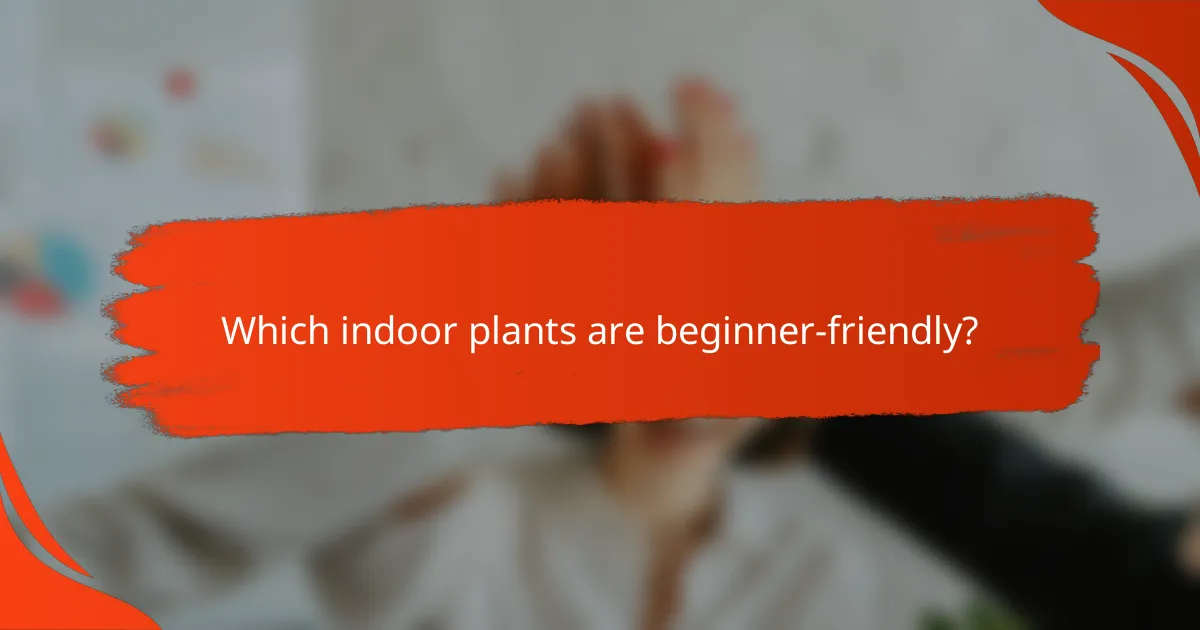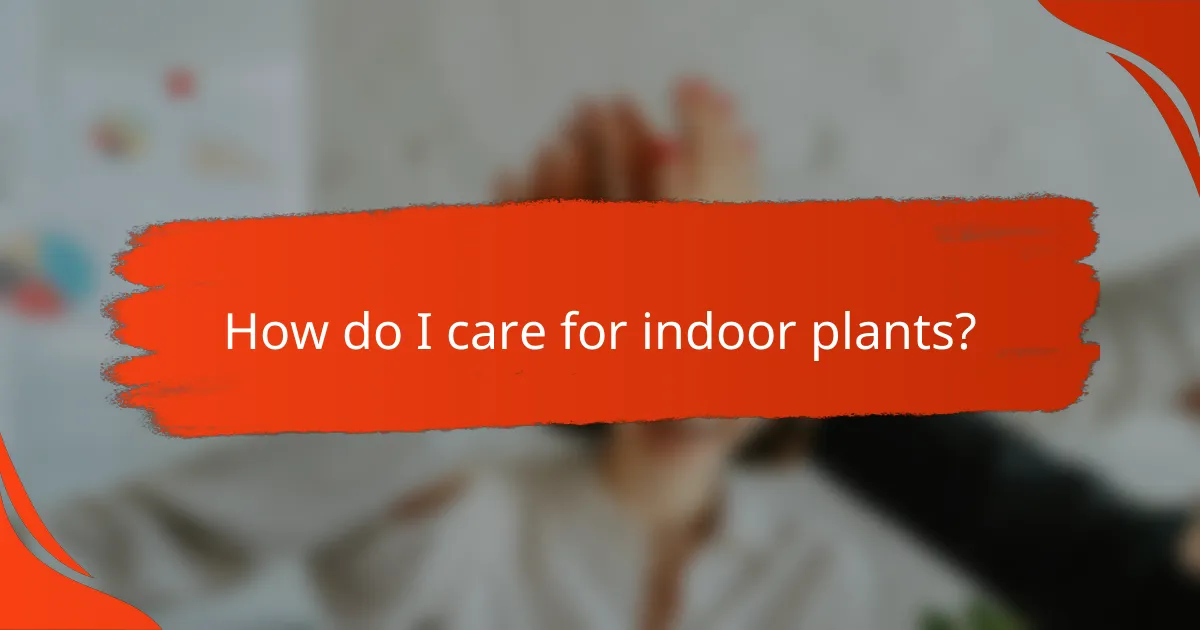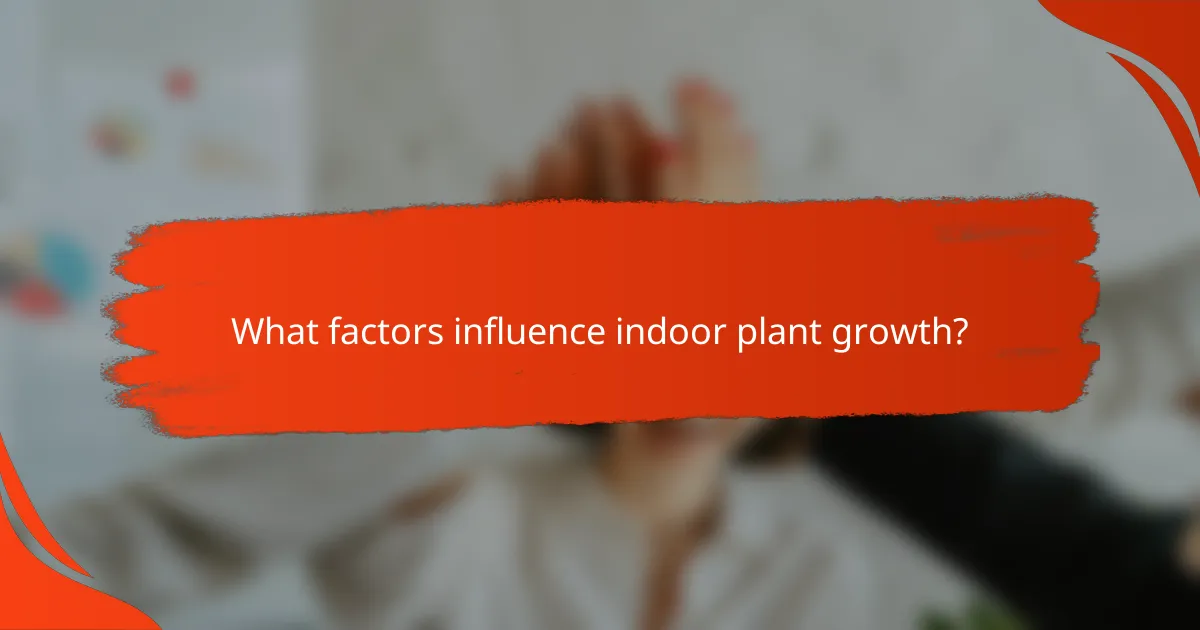Indoor plants are a fantastic way to bring life into your home, especially for beginners seeking low-maintenance options. Varieties such as Snake Plant, Pothos, and Spider Plant are not only resilient but also thrive in low light and require minimal watering. By understanding their basic care needs, you can foster a thriving indoor garden that enhances your living space.

Which indoor plants are beginner-friendly?
Beginner-friendly indoor plants are those that require minimal care and are resilient to varying conditions. Varieties like Snake Plant, Pothos, and Spider Plant thrive in low light and can tolerate infrequent watering, making them ideal for novice plant owners.
Snake Plant
Snake Plant, also known as Sansevieria, is a hardy indoor plant that can survive in low light and needs watering only when the soil is completely dry. Its upright, sword-like leaves add a modern touch to any space and can grow up to several feet tall.
This plant is also known for its air-purifying qualities, making it a great choice for improving indoor air quality. Avoid overwatering, as this can lead to root rot.
Pothos
Pothos is a versatile vine that can thrive in a variety of lighting conditions, from low light to bright, indirect sunlight. It is known for its heart-shaped leaves and can grow several feet long, making it perfect for hanging baskets or shelves.
This plant is forgiving if you forget to water it occasionally, but it prefers to dry out between waterings. Regular pruning helps maintain its shape and encourages bushier growth.
Spider Plant
Spider Plant is an attractive choice for beginners due to its ability to adapt to different environments and its low maintenance needs. It produces “baby” plants that can be easily propagated, allowing you to expand your collection effortlessly.
Spider Plants prefer bright, indirect light but can tolerate lower light levels. Water them when the top inch of soil feels dry, and watch for the development of small white flowers in the right conditions.
Peace Lily
Peace Lily is known for its beautiful white blooms and glossy green leaves, making it a popular choice for indoor decor. It thrives in low to medium light and requires watering when the soil feels dry to the touch.
This plant is also effective at filtering indoor air pollutants. However, be cautious as its leaves can droop when it needs water, serving as a natural indicator for care.
ZZ Plant
ZZ Plant, or Zamioculcas zamiifolia, is an exceptionally low-maintenance plant that can thrive in low light and requires infrequent watering. Its glossy, dark green leaves add a touch of elegance to any room.
Due to its drought tolerance, it’s perfect for busy individuals or those new to plant care. Ensure the pot has good drainage to prevent water accumulation, which can lead to root rot.

How do I care for indoor plants?
Caring for indoor plants involves understanding their specific needs regarding watering, light, soil, and fertilization. By following simple guidelines, you can create a healthy environment that promotes growth and vitality.
Watering guidelines
Watering is crucial for indoor plants, and the frequency depends on the type of plant and its environment. Generally, it’s best to water when the top inch of soil feels dry to the touch. Overwatering can lead to root rot, while underwatering may cause wilting.
As a rule of thumb, most indoor plants thrive with watering every one to two weeks. Adjust this based on humidity levels and the season; plants may require more water in warmer months.
Light requirements
Indoor plants have varying light needs, from low to bright indirect light. Assess the light conditions in your home and choose plants that match those conditions. For example, snake plants and pothos tolerate low light, while succulents and cacti prefer bright light.
Position your plants near windows but avoid direct sunlight, which can scorch leaves. If natural light is limited, consider using grow lights to supplement their needs.
Soil types
The right soil type is essential for indoor plant health. Most houseplants prefer well-draining potting mixes that retain some moisture without becoming waterlogged. Look for soil labeled for indoor plants or specific types like succulents or orchids.
Consider adding perlite or vermiculite to improve drainage and aeration. This is particularly important for plants that are sensitive to overwatering.
Fertilization tips
Fertilizing indoor plants helps provide essential nutrients that may be depleted in potting soil over time. Use a balanced, water-soluble fertilizer every four to six weeks during the growing season, typically spring and summer.
Be cautious not to over-fertilize, as this can lead to salt buildup and harm the plant. Always follow the manufacturer’s instructions for dilution and application rates.

What is the growth rate of popular indoor plants?
The growth rate of popular indoor plants varies significantly based on species, care conditions, and environment. Generally, many indoor plants can grow anywhere from a few inches to several feet per year, depending on their specific needs and the care they receive.
Growth rate of Snake Plant
The Snake Plant, or Sansevieria, is known for its slow to moderate growth rate. Under optimal conditions, it can grow about 6 to 12 inches per year. Factors such as light, watering, and temperature can influence its growth, with brighter light typically encouraging faster development.
To promote healthy growth, ensure the Snake Plant is in well-draining soil and avoid overwatering, as it prefers to dry out between waterings. Fertilizing during the growing season can also help boost its growth rate.
Growth rate of Pothos
Pothos, or Epipremnum aureum, is a fast-growing indoor plant that can grow up to 10 to 12 inches per month in ideal conditions. This plant thrives in a variety of lighting situations, although it prefers indirect light for optimal growth.
To maximize its growth, provide a balanced fertilizer every few months and ensure it has adequate humidity. Regular pruning can also encourage bushier growth and prevent it from becoming leggy.
Growth rate of Peace Lily
The Peace Lily, or Spathiphyllum, typically grows at a moderate rate, adding about 1 to 2 feet in height each year. It flourishes in low to medium light conditions and benefits from consistent moisture without waterlogging.
To enhance growth, use a balanced fertilizer during the growing season and ensure the plant is in a pot with good drainage. Regularly wiping the leaves can also help improve photosynthesis and overall health.

What factors influence indoor plant growth?
Indoor plant growth is primarily influenced by light exposure, humidity levels, and temperature ranges. Understanding these factors helps in creating an optimal environment for your plants to thrive.
Light exposure
Light exposure is crucial for photosynthesis, the process by which plants convert light into energy. Different plants require varying amounts of light; for instance, succulents thrive in bright light, while ferns prefer low light conditions.
To ensure adequate light, place your plants near windows or use grow lights if natural light is insufficient. Monitor your plants for signs of too much or too little light, such as yellowing leaves or leggy growth.
Humidity levels
Humidity levels affect a plant’s ability to absorb moisture and nutrients. Most indoor plants prefer humidity levels between 40% and 60%. Plants like peace lilies and spider plants thrive in higher humidity, while cacti and succulents do well in drier conditions.
To maintain optimal humidity, consider using a humidifier or placing a tray of water near your plants. Regular misting can also help, but avoid overdoing it to prevent mold growth.
Temperature ranges
Temperature ranges significantly impact indoor plant health. Most houseplants thrive in temperatures between 15°C and 25°C (60°F to 75°F). Extreme temperatures can stress plants, leading to stunted growth or even death.
Keep plants away from drafts, heaters, and air conditioning vents to maintain stable temperatures. Regularly check your indoor climate, especially during seasonal changes, to ensure your plants remain comfortable.


